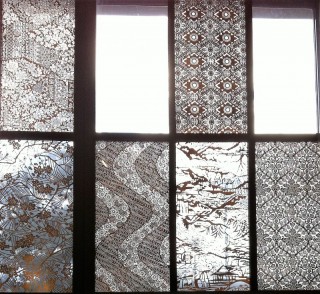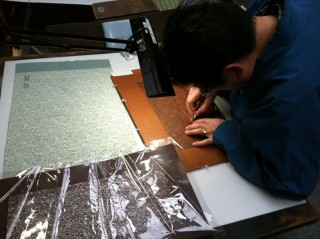Loading
Search
▼ Ise Katagami Museum
- Category:Spot

JAPAN TRAVEL
Delicacy and strength – beauty cut in paper
Have you ever heard of Ise katagami? t is a beautiful and artistic traditional Japanese art, closely related to stencil cutting. It has been used as an elegant way to decorate patterns on kimono and clothes, and is now most used for design and delicate works of art.
In Mie prefecture, a 40-minute train ride from Nagoya and the same distance from Ise Jingu, the world-famous shrine, you can find the old Shiroko village, now a district in Suzuka city. On the border with the sea, it is a calm, quiet harbor where one can enjoy the harmonious combination of blue from the sea and the sky and the clear white of snowy mountains. In the neighborhood of the museum are some old temples and shrines, such as the Ryukôji and the Koyasu-Kannon-ji, that nest between houses.
I went there to see the Ise katagami museum, where I was introduced to the deep history of Ise Katagami. According to a local legend, the technique is said to have started more than 1000 years ago and was developed in the mid-Muromachi period (1336-1573), fueling the story that the art of Katagami was developed by craftsmen running away from the burning Kyoto during the Ônin civil war. The craft reached its peak during the Edo period (1600-1867), when having a kimono dyed with the katagami technique became highly fashionable.
For many, Ise katagami is an incredible work of art. It consists of sheets of minogami, traditional Japanese paper, made waterproof with kakishibu, persimmon juice, and cut into stencil patterns with four main techniques.
For many, Ise katagami is an incredible work of art. It consists of sheets of minogami, traditional Japanese paper, made waterproof with kakishibu, persimmon juice, and cut into stencil patterns with four main techniques.
The techniques include dôgubori (where various-shaped tools are used), shimabori (parallel lines, cut one next to the other), tsukibori (delicate patterns, such as floral decorations) and kiribori (quantity of small dots form the ornamentation). Shimabori and kiribori are especially incredible, with an unimaginable degree of precision in the first technique, as each parallel line must have exactly the same length and width as the previous one, and an intricate form of pointillism for the second, where more than a hundred of dots can be made on 3cm of paper.
I personally tried the tsukibori technique, creating a free bookmark from a variety of patterns provided by the museum. I was not very good at it, but while making it, I felt a sense of achievement after having finished holing my little rabbit. What a wondrous feeling to create a beautiful and delicate ornament as the ones that are created there with mere emptiness and paper?
I had the opportunity to see two incredible craftsmen at work, Mr Uchida (who performs in the museum itself under the eyes of the visitors) and Mr Kobayashi. Looking at them, at their dexterity and sureness, I felt truly impressed. This is a technique one cannot master without years of training and a bit of genius. Some of the patterns require one to be sitting at one table, without stopping, for 8 hours. No bathroom, no food, just cutting and cutting paper up to the point where a work of art is born.
Starting with a 4cm by 4cm piece of paper, the repetition of the pattern will allow craftsmen to create a bigger piece that is then used to dye clothes, create lights or wallets or postcards. The trick is that the pattern on this piece of paper is identifiable, whichever direction you put it in, even if you fold it.
The love for this art, the kindness of people there, their willingness to protect this impressively elegant aspect of traditional Japan and the amazing experience that constitutes Ise katagami is something that I can highly recommend. Not only will you be blown away by the level of precision and delicacy of the work, but the smiles and kindness of the people around will certainly warm your heart!
By Jeanne Austry
I personally tried the tsukibori technique, creating a free bookmark from a variety of patterns provided by the museum. I was not very good at it, but while making it, I felt a sense of achievement after having finished holing my little rabbit. What a wondrous feeling to create a beautiful and delicate ornament as the ones that are created there with mere emptiness and paper?
I had the opportunity to see two incredible craftsmen at work, Mr Uchida (who performs in the museum itself under the eyes of the visitors) and Mr Kobayashi. Looking at them, at their dexterity and sureness, I felt truly impressed. This is a technique one cannot master without years of training and a bit of genius. Some of the patterns require one to be sitting at one table, without stopping, for 8 hours. No bathroom, no food, just cutting and cutting paper up to the point where a work of art is born.
Starting with a 4cm by 4cm piece of paper, the repetition of the pattern will allow craftsmen to create a bigger piece that is then used to dye clothes, create lights or wallets or postcards. The trick is that the pattern on this piece of paper is identifiable, whichever direction you put it in, even if you fold it.
The love for this art, the kindness of people there, their willingness to protect this impressively elegant aspect of traditional Japan and the amazing experience that constitutes Ise katagami is something that I can highly recommend. Not only will you be blown away by the level of precision and delicacy of the work, but the smiles and kindness of the people around will certainly warm your heart!
By Jeanne Austry
- March 30, 2017
- Comment (0)
- Trackback(0)



